![]()
[June 3, 2002]
David
Salo, author of the dialogs and inscriptions in the languages of
Middle-earth which are used in Peter Jackson's movie, has recently informed on
Elfling that he is going to
make a website with his linguistic inventions prepared for The Fellowship
of the Ring (he wrote: I have been working on putting together a web
page, but until recently I have not had much time. I hope things will come
together a little faster now, but I don't have a date when it will be ready).
Salo wrote a little about Khuzdul and Adûnaic in the movie soundtrack. On
Khuzdul: This is pseudo-Khuzdul; i.e., it's in a language which has the
same sounds as Khuzdul, and a similar morphology, and shares a few words, but
probably doesn't otherwise resemble Tolkien's Khuzdul much. On the
language heard when the Black Riders are riding: It's an attempt at Adûnaic,
what can be done with the limited data anyway.
![]()
Elvish lyrics: mysteries revealed!
[April 28, 2002]
 |
In March 2002 Warner Brothers published The
Fellowship of the Rings sheet music which included some lyric
material (both Elvish and English) not present in the CD booklet. Titles
included in this publication are: The Prophecy, Many Meetings, The
Council of Elrond Featuring "Aníron", Lament for Gandalf
(Featured in "Lothlorien"), In Dreams (Featured in "The
Breaking of the Fellowship"), May It Be.
After this publication we could find out which fragments of the
lyrics are really sung in the soundtrack. Thanks to Jaime Ondrusek
for this information!
Find out more here. |
![]()
United Cutlery Corporation: more sword inscriptions
[April 17, 2002]
Kit Rae, an Art Director of the United Cutlery Corporation, has informed us about the Elvish inscriptions on the swords occurring in The Lord of the Rings movie. This information can be found in our movie linguistic survey. The newest info concerns the sword Narsil which will occur in The Two Towers. Aragorn's reforged sword will contain a Quenya inscription which reads: Narsil essenya, macil meletya; Telchar carneron Navarotesse or 'Narsil [is] my name, a mighty sword; Telchar made me in Nogrod'. For detailed analysis of this Quenya inscription see here. |
![]()
National Geographic's Beyond the Movie: Arwen's sword
![]()
[February 19, 2002]
|
I present four captured frames from the National Geographic video entitled Beyond the Movie. This 53-minutes-long film has been published today in Polish magazine "Focus". This is an inscription from the sword of Arwen (known already from an archive report What is Arwen's sword inscription). We can see a long Sindarin tengwar inscription (see above). Its first words, according to Gildor Inglorion, are Aen estant Hadhathang i chathol hein-thand '[It] was named Throng-cleaver, the broadsword-blade, shield [=defence?] [to] them...' . As we can see Arwen's sword is named Hadhathang 'Throng-cleaver' in the film; cf. Sangahyando in LR 389. For detailed analysis see here. UPDATE! According to Kit Rae, an Art Director of the United Cutlery Corporation, Arwen's sword name is Hadhafang 'Throng-cleaver' (Sindarin version of the the Quenya name Sangahyando). The movie background for the name Hadhafang is this: It once belonged to the Elvish princess Idril, who wed a mortal man Tuor and bore Eärendil, the father of Elrond who in turn was father to Arwen. For whole inscription and for its analysis see here. |
![]()
Official movie website: More about Elvish!
[February 14, 2002]
| The official LotR:FotR movie
website's last update is good news for anyone who loves the Elvish
languages. On the web-page entitled Elvish
Translator you can find few Elvish (Sindarin) dialogs and phrases
from the movie with transcription and translation. Thanks to the Audio
Guide you may listen to three Sindarin sound-clips (Arwen and
Aragorn in Rivendell, Galadriel in Lothlórien and Arwen and Aragorn
before Bruinen Ford) illustrated with the photos from the film.
There is also a very interesting exclusive online video 'behind the scenes' with three Sindarin phrases not found in The Fellowship of the Ring. Two of them were presented by me here and here; the third one, by Elrond, is more or less I aear can ven amar (maybe somebody can decipher this sentence?). The video presents the work of the language coaches, and contains interviews with Liv Tyler, Viggo Mortensen, Orlando Bloom and Director Peter Jackson. You can also send your friends an Elvish greeting from The Lord of the Rings with customizable postcards! UPDATE! According to Javier Lorenzo the Hugo Weaving's (Elrond's) Sindarin phrase reads: I Aear cân ven «Namar» or 'The Sea calls us "Farewell"'. Does it come from The Return of the King? |
![]()
Sound clips with Elvish dialogs!
[February 14, 2002]
| Thanks to the help of Thomas Deece you may listen now to all Sindarin and Quenya dialogs and phrases from LotR:FotR film. Gwaith-i-Phethdain presents multimedial Dialogs: a linguistic survey! |
|
|
![]()
[January 16, 2002]
| On TheOneRing.net we can read that Cate Blanchet has confirmed on Fresh Air that there were more Elvish dialogs in the movie. Probably the DVD version of the Fellowship of the Ring (in shops in July 2002) will contain a scene with Aragorn and Galadriel speaking Sindarin, and maybe also there will be more dialogs between Aragorn and Arwen, and between the Fellowship and the Lórien guard. Some of these dialogs you can find in Dialogs: a linguistic survey. |
|
|
![]()
Tolkien's languages in the FotR movie: linguistic survey
[January 10, 2002]
| Finally we can see all the Elvish (Sindarin and Quenya) and Khuzdul dialogs that appear in the movie dialog list. Thanks to our reporter Gwaith-i-Phethdain presents Dialogs: a linguistic survey. Cuio mae! |
|
|
![]()
[December 18, 2001]
| Its almost ready: here you can find a lexical analysis of the Elvish lyrics in the LotR soundtrack. Discover every single word put together into Elvish lyrics by David Salo! |
|
|
![]()
More linguistic items from Casa Loma
[November 13, 2001]
[From Patrice Blancho]
| On Fotki.com you can find a lot of new interesting photos from Casa Loma exhibition in Toronto. Let us take a look at Glamdring, Aragorn's knife, etc. See here. |
|
|
![]()
[November 10, 2001]
[From Morrigan]
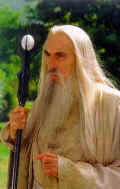 Christopher Lee as Saruman |
Italian
website Cinema has
presented a sound
file with Christopher Lee (Saruman) reciting a phrase in Elvish! During
the interview
with Christopher Lee at the Verona Film Festival where Lee was
President of the Jury, Francesco
Alò asked him to
tell a line in the Elvish language Sindarin (see below). Lee speaks in Quenya (not in
Sindarin as he claims!) His pronunciation is very fast and it is difficult
to transcribe the whole Elvish text. Thanks to my friend who is in
possession of the dialog list this phrase - we can call it 'Saruman's
Weather Spell' - is finally clear. He wrote: "This
spell is uttered in the moment when the Fellowship ascends Caradhras;
Saruman is, of course, not physically present, but he observes (and
comments) the fellowship's fruitless attempts to head to the East. He
obviously is |
|
In the version of the dialogue I have, the spell is written as:
Cuiva nwalca Carnirassë; nai yarvaxëa rasselya.
Then comes Gandalf's try to soothe the mountain:
Losto caradhras, sedho, hodo, nuitho i ruith.
And then again Saruman's voice:
Cuiva nwalca Carnirassë; nai yarvaxëa rasselya; talhira notto-karinnar
On
tape, the scene sounds different: First we hear Saruman's voice, mostly
ununderstandable, but the last word is clearly rasselya, stressed
on the first syllable.
See here for the linguistic comment.
* * * And this is a fragment of the review:
What
about the languages spoken in the movie. Which is Saruman's accent?
Christopher Lee: No accents. I speak normally. There are British actors, Australian actors, Newzeland actors, American actors. And actresses of course. We all speak English without accents. The other languages are Elvish: Sindarin and Quenya. You can learn Elvish, if you want. It's a language like Italian and English. You can learn to read it, you can learn to write it and you can learn to speak it. The Elvish languages are two. Sindarin is, basically, Welsh. More or less. Quenya is Finnish. Most of the elves speak Sindarin and most of the characters do speak Elvish. Not all the time. I also speak a bit. And there will be subtitles during these Elvish conversations. Does Saruman talk Sindarin or Quenya in the movie? Christopher
Lee: Sindarin.
It was extremely difficult. (At this moment Christopher Lee said an entire
line in Sindarin - see above). |
|
|
![]()
[November 10, 2001]
[From TheOneRing.net and Colleen Meade]
|
UPDATE! Harri Perälä has sent this link. We can read there: Identical
Tattoos: A Great Way to Bond. |
|
|
![]()
Her name is Arwen. Her sword is Gwemegil
[November 8, 2001]
[From Decipher and P. Roger Sweets]
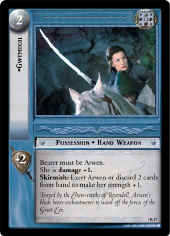
Gwemegil |
Decipher has presented recently a card with... Arwen's sword. Its name is Gwemegil. This name must have been invented by the language specialists in the LotR movie.
What does Gwemegil mean? Maybe 'Maiden's Sword'? As we can read on the card: "Forged by the Elven-smiths of Rivendell, Arwen's blade bears enchantments to ward off the forces of the Great Eye". Last month I presented a picture with details of the Gwemegil blade and I asked for your help in deciphering the last part of its inscription [see here]. Because the last tengwar letters seem to be e (35) and n (21) I guess the last word of the Gwemegil inscription may be Hen 'Eye'. If so, maybe the whole text of Arwen's blade is:
Gwemegil Arwen dan choth Beleg Hen 'Maiden-sword [of] Arwen against [the] host [of] Great Eye'
|
|
The
form Gwemegil is interesting too. It consists of two elements: gwend
'maiden' + megil 'sword'. Language specialist who invented this
name (David Salo?) claims that -nn-m- > -m-. What do you
think about this?
UPDATE! Gwemegil's name occurs only on the Decipher's card. You will not find it in the movie! Gwemegil < *gwemmegil < gwen-megil (as Boromir < *borommir < boron-mir). |
|
|
![]()
What do you hear in "Aníron" by Enya?
[November 8, 2001]
 |
"Aníron" by Enya as presented at the French website Le Film is very hard to interpret. Some linguistists have tried to write down what they hear in the MP3 file. This is the result. I wonder who of them is closer to the original. We will see on November 20 when the CD is in our shops.
|
|
Javier
Lorenzo: ava cheb i .... / ??chae aníron Undómiel
// tíron ir ??eriad...._?? / chae aníron 'the ???
won't keep .... / far [lenited] I wish Undómiel // I watch the rising
.... / far [lenited] I wish.
Gildor Inglorion: aba chae iluidu imlasidi ADERTHIA / ANIRON UNDÓMIEL // TIRO eria epe enitepe peadaepe / AI ANIRON UPDATE! Enya's song can be finally found in the Soundtrack: a linguistic survey where I analyze all the Elvish lyrics from the movie soundtrack. |
|
|
![]()
New soundtrack: Aniron and Lothlórien
[November 2, 2001]
[From Le Film]
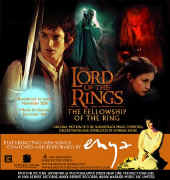 |
French website Le Film presents three fragments of the LotR movie soundtrack. The most interesting are Aniron and Lothlórien with Elvish lyrics. Unfortunately the quality is not good and I cannot separate individual words. Maybe somebody can help?
TheOneRing.net has published whole lyrics of May It Be previously published on Gwaith-i-Phethdain by Javier Lorenzo.
|
![]()
Linguistic items from Casa Loma exhibit
[November 2, 2001]
[From TheOneRing.net]
Among many reports from Casa Loma LotR movie exhibit we find many interesting pictures. Some of them contain wonderful linguistic stuff: wall and sword inscriptions, beautiful Hobbit calligraphy, etc. Let us take a look! [More]
![]()
[November 1, 2001]
[From Javier Lorenzo]
Tolkien Online has published a link to May It Be, one of the songs specially made by Enya, available for download. This song contains two Elvish sentences: Mornië utúlië 'Darkness has come' and Mornië alantië 'Darkness has fallen'.
![]()
Dwarvish runes: Eris Caffee's transcription
[October 29, 2001]
|
Eris Caffee (Moriel) has made a great effort! Look at her interpretation of the runic inscriptions in the halls of Moria. Eris writes: The following images are blown up details of several images from the Moria scenes of New Line's Fellowship of the Ring that have recently been released/escaped into the wild. In the details below, you will find both a mostly unprocessed version of the image, and a version in which I have drawn the lines of the runes that I believe I have found. I have not always found complete runes, but in cases where I see lines that I feel confident belong to runes, I have marked them in the hopes that they will give a clue as to what the complete rune looks like... See Eris' website. [More] |
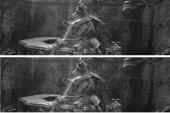
|
According to Eris this inscription reads: d u r i n u l? g ... kh a z a d d u m |
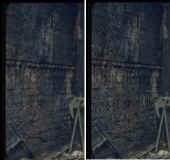
|
According to Eris: n t u r g u l kh a z a d d [u m]
|

|
According to Eris: i o i d r e . l m ... e d e a th l e s s |
![]()
[October 25, 2001]
Czech website Film Pán prstenu mentioned recently on this website presents more and more interesting photos from the movie. Some of them contain very nice linguistic material. See these two pictures from Moria and try to decipher the cirth on the walls. It is a very interesting challenge! Send your results to Gwaith-i-Phethdain!
|
A great Moria hall. Statues of three Dwarvish kings (?) with runic inscriptions. Ready to be deciphered! |
Mazarbul Gate. Many runic inscriptions on the wall. Try to read them! |
![]()
Book of Mazarbul and more runes
[October 24, 2001]
|
Czech website Film Pán prstenu contains a lot of interesting photos from the LotR movie. We present one of them (on the right) with Book of Mazarbul (lit. 'Book of Records'). The huge book has a runic inscription which according to Patrice Blancho reads: mazarb zigintarâg khazaddûmul or 'Records [of] Long-Beards [= Dwarves] [of] Moria'.
The book lies on the Balin's tomb with runic inscriptions known from The Fellowship of the Ring by J.R.R. Tolkien. See here for the analysis. |
Book of Mazarbul |
|
R.D. |
![]()
[October 23, 2001]
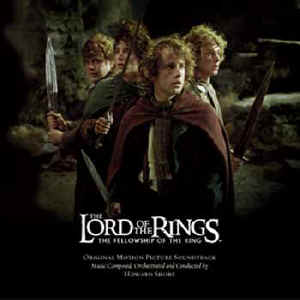
The soundtrack cover |
Great news! |
|
R.D.
|
![]()
[October 18, 2001]
| [From Patrice Blancho]
This is Glamdring, sword of Gandaf forged in Gondolin in Elder Days. TheOneRing.net presents this picture among many other products of United Cutlery. It is probably a copy of the sword used in the LotR movie. The sword has few runic inscriptions written in Sindarin. We can read in the center: Glamdring and with smaller characters: Turgon Aran Gondolin... I need your help. I am not able to decipher all the inscription and I hope you can help me. If you have any ideas write to me. |
|
R.D.
|
![]()